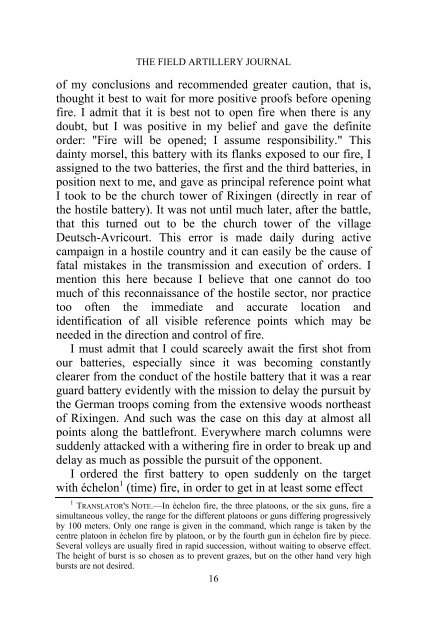the field artillery journal - Fort Sill - U.S. Army
the field artillery journal - Fort Sill - U.S. Army
the field artillery journal - Fort Sill - U.S. Army
Create successful ePaper yourself
Turn your PDF publications into a flip-book with our unique Google optimized e-Paper software.
THE FIELD ARTILLERY JOURNAL<br />
of my conclusions and recommended greater caution, that is,<br />
thought it best to wait for more positive proofs before opening<br />
fire. I admit that it is best not to open fire when <strong>the</strong>re is any<br />
doubt, but I was positive in my belief and gave <strong>the</strong> definite<br />
order: "Fire will be opened; I assume responsibility." This<br />
dainty morsel, this battery with its flanks exposed to our fire, I<br />
assigned to <strong>the</strong> two batteries, <strong>the</strong> first and <strong>the</strong> third batteries, in<br />
position next to me, and gave as principal reference point what<br />
I took to be <strong>the</strong> church tower of Rixingen (directly in rear of<br />
<strong>the</strong> hostile battery). It was not until much later, after <strong>the</strong> battle,<br />
that this turned out to be <strong>the</strong> church tower of <strong>the</strong> village<br />
Deutsch-Avricourt. This error is made daily during active<br />
campaign in a hostile country and it can easily be <strong>the</strong> cause of<br />
fatal mistakes in <strong>the</strong> transmission and execution of orders. I<br />
mention this here because I believe that one cannot do too<br />
much of this reconnaissance of <strong>the</strong> hostile sector, nor practice<br />
too often <strong>the</strong> immediate and accurate location and<br />
identification of all visible reference points which may be<br />
needed in <strong>the</strong> direction and control of fire.<br />
I must admit that I could scareely await <strong>the</strong> first shot from<br />
our batteries, especially since it was becoming constantly<br />
clearer from <strong>the</strong> conduct of <strong>the</strong> hostile battery that it was a rear<br />
guard battery evidently with <strong>the</strong> mission to delay <strong>the</strong> pursuit by<br />
<strong>the</strong> German troops coming from <strong>the</strong> extensive woods nor<strong>the</strong>ast<br />
of Rixingen. And such was <strong>the</strong> case on this day at almost all<br />
points along <strong>the</strong> battlefront. Everywhere march columns were<br />
suddenly attacked with a wi<strong>the</strong>ring fire in order to break up and<br />
delay as much as possible <strong>the</strong> pursuit of <strong>the</strong> opponent.<br />
I ordered <strong>the</strong> first battery to open suddenly on <strong>the</strong> target<br />
with échelon 1 (time) fire, in order to get in at least some effect<br />
1 TRANSLATOR'S NOTE.—In échelon fire, <strong>the</strong> three platoons, or <strong>the</strong> six guns, fire a<br />
simultaneous volley, <strong>the</strong> range for <strong>the</strong> different platoons or guns differing progressively<br />
by 100 meters. Only one range is given in <strong>the</strong> command, which range is taken by <strong>the</strong><br />
centre platoon in échelon fire by platoon, or by <strong>the</strong> fourth gun in échelon fire by piece.<br />
Several volleys are usually fired in rapid succession, without waiting to observe effect.<br />
The height of burst is so chosen as to prevent grazes, but on <strong>the</strong> o<strong>the</strong>r hand very high<br />
bursts are not desired.<br />
16

















